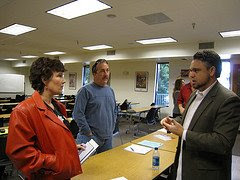By: Patricia Rockwell
Language scholar and philosopher Paul Grice developed a theory of communication in 1975 that linguists use today. It is such a simple, elegant theory that it goes beyond the realm of scientists and teachers, and truly enlightens the daily communication activities of everyday communicators. Grice describes one common underlying principle—what he calls the cooperative principle and four conversational maxims. He suggests that all communication can be understood by understanding this principle and its four accompanying maxims.

The one underlying principle of all communication, says Grice, is that we use language to accomplish goals and we do so by sharing information (the cooperative principle). We (or rather our ancestors) devised language and communication in order to get things done. Obviously, some of our ancestors wanted to accomplish some things and others wanted to accomplish other things. Today, we probably want to accomplish things our ancestors never thought of. In other words, in any language act, there are multiple goals, for a person and for people in general. However, language would not have been invented (if that is the best word) if our ancestors had not needed it to accomplish something (e.g., maybe warning their neighbor of an approaching wooly mammoth).
Today, language works as long as it satisfies this cooperative principle. As long as language allows us to accomplish our goals, we continue to use it. In most instances, our goals involve sharing our ideas with others and language allows us to do that. It would be difficult to share our ideas with other people without the use of language. It doesn’t matter how sophisticated your language is or my language is, if we do not share the same language, we will not be sharing our ideas.
Of course, communication doesn’t stop there. Just the fact that we share the same language doesn’t necessarily mean that we will understand each other completely. This is where Grice’s four conversational maxims come into play. These maxims are the specifics of how we put the conversational principle into practice in every day communication. Grice says there are four conversational maxims: 1) quantity, 2) quality, 3) relevance, and 4) manner. Let’s look at each one and see how each can both enhance and diminish communication.
First, let’s look at quantity. Grice tells us that all messages should contain the appropriate amount of information—not too much, not too little. If, for example, you are trying to bake a cake and the recipe calls for flour, sugar, milk, butter, and chocolate, you would probably say to yourself, “well, that’s not enough information. I need to know how much of each ingredient I need.” In this case, the message producer has not supplied the necessary amount of information. On the other hand, if the recipe gave the ingredients and the amount, but then went on to describe how the cake was originally developed and what famous people had eaten it, and multiple different sources where you could purchase the ingredients needed in the cake, you might think, “that’s nice, but I really just need the recipe.”  In this case, the message producer has given more than enough, probably too much information. I am certain that you have experienced both of these situations many times (maybe even while blogging). If there is too much information, you have to wade through a lot of extra stuff until you find the meat of the message. If there is insufficient information, you cannot use the information you are given because something is missing. Quantity is a maxim most of us take for granted. We don’t recognize its importance until we discover a violation against it.
In this case, the message producer has given more than enough, probably too much information. I am certain that you have experienced both of these situations many times (maybe even while blogging). If there is too much information, you have to wade through a lot of extra stuff until you find the meat of the message. If there is insufficient information, you cannot use the information you are given because something is missing. Quantity is a maxim most of us take for granted. We don’t recognize its importance until we discover a violation against it.
Second, we have the maxim of quality. Here, quality implies truth. Grice suggests that all communicators are expected to be truthful. Of course, this does not always happen. However, he argues, it is an expectation of normal conversation. For example, when you stop and ask for directions, you don’t expect that someone will intentionally give you false directions. When someone asks you if it’s raining outside, you will more than likely answer truthfully. When we lie, we generally do so for a reason that has something to do with our relationship with the other person in the conversation. People list numerous acceptable reasons for lying—typically to prevent a person from suffering hurt feelings is often listed. However, most research indicates that the most common reason for actually violating the maxim of quality is to protect oneself from losing face. Other acceptable reasons for violating or flaunting the quality maxim include humor and sarcasm. However, with sarcasm and humor, most individuals indicate with nonverbal cues that they are providing false information so that the listener will not take them literally.
Third, Grice mentions the maxim of relevance. That is, communicators are expected to provide information that is relevant to the conversation at hand. If you ask me what time it is and I respond, “I like bananas,” then you might say my answer is not relevant. The maxim of relevance is violated rather frequently in conversation. Obviously, what is relevant to one speaker is not always relevant to another. However, speakers who constantly fail to maintain relevance in their conversations will annoy (at the least) their conversational partners. Often, failure to be relevant in a conversation can be traced back to poor listening habits. People become wrapped up in their own concerns and worry more about what they are going to say next rather than listening and understanding what the other person is saying at the moment.
Finally, the maxim of manner is described by Grice. Whereas the other three maxims involve content (the what), this maxim involves procedure (the how). Grice says that effective communicators use a manner appropriate to the situation. For example, if speaking to a child, communicators should probably use shorter sentences, simpler words, and speak more slowly than they would with an adult. Or, if a man is proposing marriage to his beloved over a romantic dinner in a restaurant, he should probably not use the same language and style that he would when cheering at a football game.
Choosing the best style for communicating a particular message is not easy. Should you be energetic? Relaxed? Friendly? Reserved? Just how should your message be conveyed? Obviously, the more important the message, the more effort you will put into determining the manner of its delivery.
It’s amazing how one simple principle—the cooperative principle (language allows us to accomplish goals) and its four subsidiary maxims of quantity, quality, relevance, and manner, work together so beautifully to explain how communication functions in our daily lives. We have Paul Grice to thank for these ideas—and good ideas they are for all of us to remember if we wish to be better communicators.
ABOUT THE AUTHOR
Patricia Rockwell 
is a retired professor from Illinois and is the author of two blogs , Subjective Soup and Communication Exchange .
These two blogs are rich in significant information and well written articles, that I could not refuse her entry to my soon to be published book. I guess without good communication, inspiration can’t take place, right?
She says, “Life is a bowl of soup, chock full of adventure. Here is my take.”
Thanks Patricia for being a contributor. I am honored.
If you want to be more informed about academics and on a lot of a variety of topics visit her dynamic blogs.
Patricia’s Post about this article .
Photo 1 by pedrosimoes7
Photo 2 by Dru Bloomfield – At Home…










